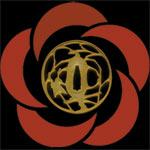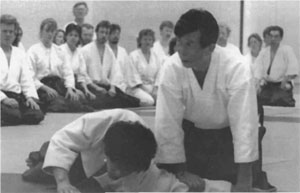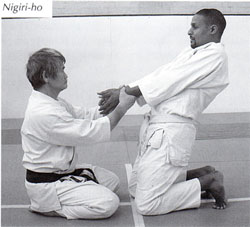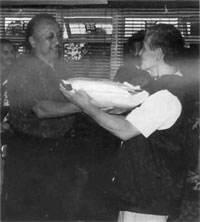 |
About the influences on his Aikido developmentby Peter Megann, B.A.F. General Secretary// Источник: B.A.F. Newsletter, Январь 2005, No 49In October this year Peter Megann talked to Kanetsuka Sensei about the influences on his Aikido development
PM: On quite a few occasions over the last few years, Sensei, we've heard you say how grateful you feel towards your teachers and how lucky you've been to be able to learn something from them. When did you start Aikido and who were your first teachers? KS: My first Aikido teachers were Fujita Sensei and Shioda Sensei. This was when I was attending Takushoku University in Tokyo from 1956. Fujita Sensei, my sempai*, had started an Aikido club at the university and I attended his classes at lunchtimes. Then later in the afternoon I travelled to Shioda Sensei's dojo and practiced there for maybe four or five hours. You must know that when I started Aikido I didn't see many things. At that time I didn't study many techniques. Very basic things. PM: So what did you learn from Shioda Sensei? KS: Practice at Shioda Sensei's dojo was very simple. Nothing complicated. We used to begin with basic preparatory exercises such as hiriki-no yosei ('elbow power exercise') and finished with haishin-undo ('back-stretch'). We did only very basic techniques like suwari-waza and tachi-waza shomen-uchi ikkyo, and a lot of hanmi-handachi shiho-nage, and in ushiro-waza maybe ryote-dori sankyo. Shomen-uchi nikyo and kata-dori nikyo were other techniques that we practised regularly. And we always finished with suwari-waza shomen-uchi nikyo and nigiri-ho ('gripping exercise'). This is all I remember from that time. maybe because I was a junior. No kaiten-nage, no kokyu-nage. PM: And no koshi-nage? KS: No koshi-nage at all! I never saw koshi-nage except maybe in demonstrations. PM: So, looking back to your time under Shioda Sensei, what important elements did you absorb? KS: Number one, the use of the hands (te-sabaki). Opening the hands and making use of the wrists and elbows. Then kamae (stance): solid, low posture. And expanding, not shrinking. Concentration on the toes — the big toes: no jumping. Relaxed shoulders. Me-tsuke: looking steadfastly in front of you and seeing all the partner from head to toes. PM: And what did you learn from Fujita Sensei in those early days? KS: Fujita Sensei had practised a good many years with O-Sensei and passed on what he had learnt. He emphasized the importance of exercises. In warming-up he did makko-ho and basic tori-fune, and shiho-giri tenkan-ho. Actually much of what is shown in the first part of the B.A.F. Teaching Videos 1 & 2 I learnt from him. PM: This is interesting because I think that, because you put great emphasis on those exercises, many people think 'this is all Kanetsuka Sensei's Aikido'. K.S: No, no! Ueshiba Sensei was doing these kinds of exercises every day. And all techniques are based on this. I discovered this later. When I was at university, I must admit, I wasn't very interested in such exercises. PM: Another teacher who had an important influence on your Aikido was, I believe, Yamaguchi Sensei, even though you never attended his classes in Japan. So what did you gain from him? KS: Well he was always very relaxed both as a person and physically. His shoulders were always very relaxed and his hands were simply hanging. He first came to England for the B.A.F. Summer School at Shenstone College in 1974 and later he came to Oxford for B.U.A.F. courses each year from 1987 to 1989. He showed sitting ukemi, rolling backwards and forwards; and I remember how he applied the principle of deep tori-fune to techniques like shiho-nage and irimi-nage. By shifting his centre of gravity forwards and backwards, as in shiho-nage, for example, he was able to make the partner lose his balance so that there was no need to force the technique. His stance was very solid, like a pyramid, though his Aikido was very fluid. For him there was no difference between tachi-waza and suwari-waza: the one merged with the other. PM: And although Yamaguchi Sensei had done much kashima sword-work, he advised against doing too much sword-work.
KS: Yes; he said 'stop sword'. In fact Fujita Sensei said the same thing: not to spend a lot of time on sword-practice but just understand the principles of sword-movement. And at Shioda Sensei's dojo we never did any sword-work. As you say, I didn't attend any of Yamaguchi Sensei's classes in Japan so I was very lucky that he came to Oxford on >those occasions because I learnt a lot from him. If I use a sword these days it's not as a weapon but as a tool for studying and showing Aikido principles, and how to use the wrists, forearms and elbows as a sword (te-gatana/shuto). PM: Yamaguchi Sensei's Aikido was very basic, too. KS: Yes; very basic. No special techniques. PM: Of course Sekiya Sensei had been a student of Shioda Sensei and later of Yamaguchi Sensei, and during the 12 months that he stayed with you in London in 1978 I believe he passed on to you the principle of atari. KS: Yes; the principle of atari is very important. Contact: musubi. PM: Can you explain that? KS: It's like when you are fishing. You throw out the line with a hook, but unless a fish actually gets caught on the hook, you cannot pull it in. In Aikido, unless you make some real contact with your partner you cannot effect a technique. Whether the point of contact is your wrist, as with katate-dori and shomen-uchi etc, or with your shoulder (kata-dori), you must make contact through it with you partner's centre. PM: 1978 was the year that Saito Sensei came to Britain and gave a memorable course in Harrow. KS: Yes; I learnt some very important things from him when he stayed for three days in my house in Hampstead. He showed how to lower the tanden and cope with two attackers. When he was pinned to the wall with attackers grasping both his shoulders and couldn't move forward or backwards, he managed without any difficulty. PM: Ah, so that's why you often show that situation when you take a class at the Oxford Dojo! And Chiba Sensei, what do you think you owe to him? KS: Most important he introduced me to the Aikido of Saito Sensei and of Yamaguchi Sensei. He said to me that I should first study basic kashima sword-work and especially kesa-giri (diagonal cutting) from Sekiya Sensei. Without this I would not understand Yamaguchi Sensei's Aikido. PM: In recent years you have shown a lot of interest in Karate. You clearly feel that we can learn something from eminent Karate teachers like Suzuki Tatsuo Sensei from Wado Ryu, Ohta Yoshinobu Sensei from Shotokan (JKA) and Nakamura Tatsuo Sensei from Kyokushinkan. KS: Actually I've been in contact with Karate for a long time. My university (Tokushoku University) was well known for Karate. Nakayama Sensei, the Technical Director of the Japan Karate Association, was teaching Karate when I was there, and previously the late Enoida Sensei was a student as well as Kanazawa Sensei. All famous names. PM: So what do you think we can learn from Karate? KS: Well first of all the discipline. My five year old son, Masaki, attends a children's class and, watching it, I am very impressed by the discipline that is instilled into the children there. I think it's very good for them and is something that is lacking these days in schools. And I like to see them doing basic exercises at every practice, even the instructors. Of course, Aikido practitioners can learn from these top Karate teachers how to react to good tsuki. In fact, if we are to defend against tsuki, we must know how to make tsuki properly. Also, we can learn how to move out of the line of attack with minimum tai-sabaki and at the same time be able to defend ourselves. Survival is of course of the greatest importance and in my life I have encountered quite a number of life-threatening situations. When I was travelling around Nepal and India (between 1965 and 1971) I experienced several very dangerous moments and thanks to Aikido, to my quick and natural reactions, I managed to deal with them. And of course, when I had cancer in 1986 fortunately I survived. PM: I think that what this all shows. Sensei, is that you have a very open mind and you have been able to benefit from a lot of influences in your Aikido career; and you have as a result developed a very personal Aikido. An Aikido which has no call for strength or vigour, an Aikido for everybody: for children, for elderly people just as much as for young, active people. I believe that this has been your goal.
* Professor Peter Goldsbury writes about SEMPAI and KOHAI... |
||||||
| © Рюсинкан.ру |



